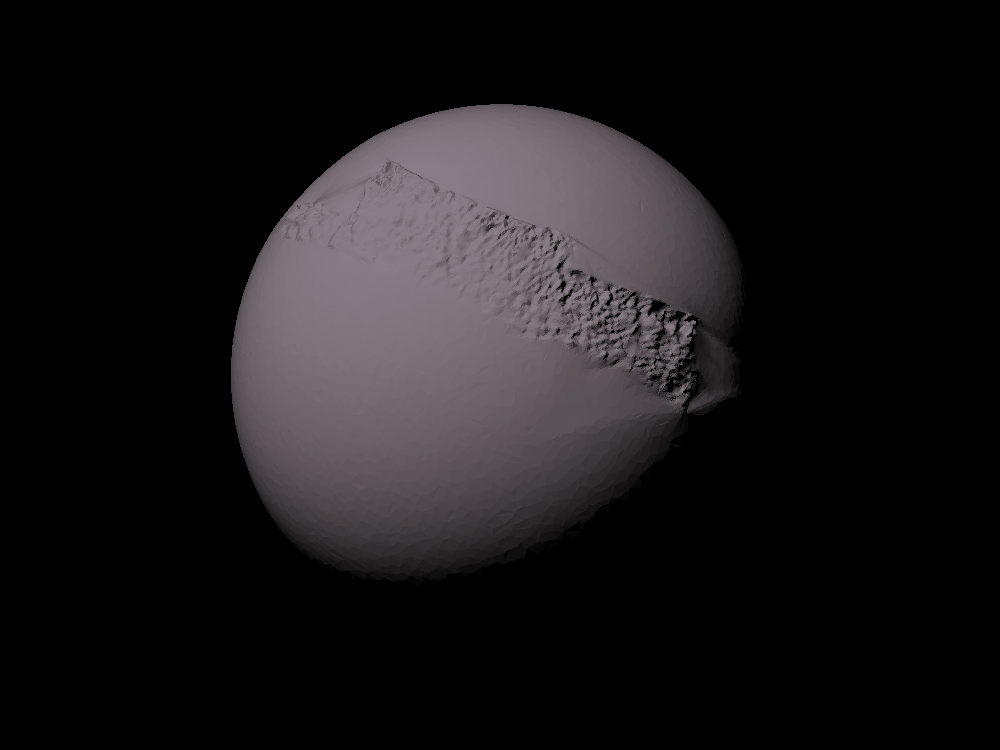
Triton with known topography scaled one in twenty million
prusaprinters
<p>Originally published here: <a href="https://www.thingiverse.com/thing:3433957">Triton with known topography scaled one in twenty million by tato_713 - Thingiverse</a></p><p>This model was rendered using MATLAB R2016a on topographic map from Schenk (2008), made with the images from the Voyager mission. When the Voyager 2 probe flew by Triton, took very few pictures of it. Less than a half of its surface is known, so the topography that can be deduced from photometry is reduced to a little patch. The rest was filled by interpolation with many randomly distributed points of the same mean radius height.<br>Notice that the patch of topography showed is from what is usually considered the south hemisphere. When the Voyager 2 fly by the Neptunian system, the south pole of Neptune was pointing to the Sun. However, since Triton has a retrograde orbit, and it is tidal locked, following the right hand rule, the north pole of the moon is pointing to the Neptune's south; so the visible hemisphere was actually the north one.<br>The file's names explained:<i>name_1_x_10_y.stl</i> is 1 : x* 10^y. So _1_6_10_7 is 1:600000000 or one in 60 million. </p><h4>N1 Triton</h4><p>Triton is the biggest known irregular satellite, the biggest moon of <a href="https://www.prusaprinters.org/prints/57330-neptune-scaled-one-in-250-million">Neptune</a>, and the biggest compared with its parent planet of the gas planets. Irregular moons have high inclined, high eccentric (not in the case of Triton) and retrograde orbit. They orbited directly the Sun before being captured by its planet. In the case of Triton, it is thought that it was a <a href="https://www.prusaprinters.org/prints/57288-largest-tnos-and-their-moons-shapes-scaled-one-in-">TNO</a> (trans Neptune object) because of the similar composition with them. If that was the case, it had the sufficient mass and size to be a dwarf planet. It is bigger than <a href="https://www.prusaprinters.org/prints/57250-pluto-and-charon-with-known-topography-scaled-one-">Pluto</a> and Eris. The moon's capture also helped to deplete the <a href="https://www.prusaprinters.org/social/120859-tato_713/collections/49345">Neptunian System</a> of medium sized moons by collision or gravitational interactions with them.</p><ul><li><strong>Type:</strong> Satellite </li><li><strong>Orbit:</strong> Neptune. Irregular. </li><li><strong>Orbital period:</strong> 5.876 d. </li><li><strong>Composition:</strong> Icy body, subsurface ocean. </li><li><strong>Density:</strong> 2.061 g/cm3. </li><li><strong>Dimensions:</strong> 2706.8 km </li><li><strong>Model scale:</strong> 1:2x107 (14cm)</li></ul><h4>References</h4><ul><li>P. M. Schenk. Cartographic and topographic mapping of the icy satellites of the outer solar system. 2008 .</li><li><a href="https://www.mathworks.com/matlabcentral/fileexchange/4512-surf2stl">Surf to STL function for MATLAB </a></li></ul><h3>Other astronomical objects</h3><p><a href="https://www.prusaprinters.org/social/120859-tato_713/collections/49826">Inner Solar System</a></p><p><a href="https://www.prusaprinters.org/social/120859-tato_713/collections/49832">Artificial</a></p><p><a href="https://www.prusaprinters.org/social/120859-tato_713/collections/49820">Near Earth Asteroids</a></p><p><a href="https://www.prusaprinters.org/social/120859-tato_713/collections/49291">Main Belt Asteroids</a></p><p><a href="https://www.prusaprinters.org/social/120859-tato_713/collections/49829">Jovian System</a></p><p><a href="https://www.prusaprinters.org/social/120859-tato_713/collections/49828">Saturn System</a></p><p><a href="https://www.prusaprinters.org/social/120859-tato_713/collections/49830">Uranian System</a></p><p><a href="https://www.prusaprinters.org/social/120859-tato_713/collections/49345">Neptunian System</a></p><p><a href="https://www.prusaprinters.org/social/120859-tato_713/collections/49827">Centaurs</a></p><p><a href="https://www.prusaprinters.org/social/120859-tato_713/collections/49833">Comets</a></p><p><a href="https://www.prusaprinters.org/social/120859-tato_713/collections/49341">Trans Neptunian Objects</a></p><p><a href="https://www.prusaprinters.org/social/120859-tato_713/collections/49824">Extrasolar Objects</a></p><p><a href="https://www.prusaprinters.org/social/120859-tato_713/collections/49837">Sky Maps</a></p><p><a href="https://www.prusaprinters.org/social/120859-tato_713/collections/49831">Ancient</a></p><p><a href="https://www.prusaprinters.org/social/120859-tato_713/collections/49822">Speculative</a></p><p><a href="https://www.prusaprinters.org/social/120859-tato_713/collections/49821">Science Fiction</a></p>
With this file you will be able to print Triton with known topography scaled one in twenty million with your 3D printer. Click on the button and save the file on your computer to work, edit or customize your design. You can also find more 3D designs for printers on Triton with known topography scaled one in twenty million.
